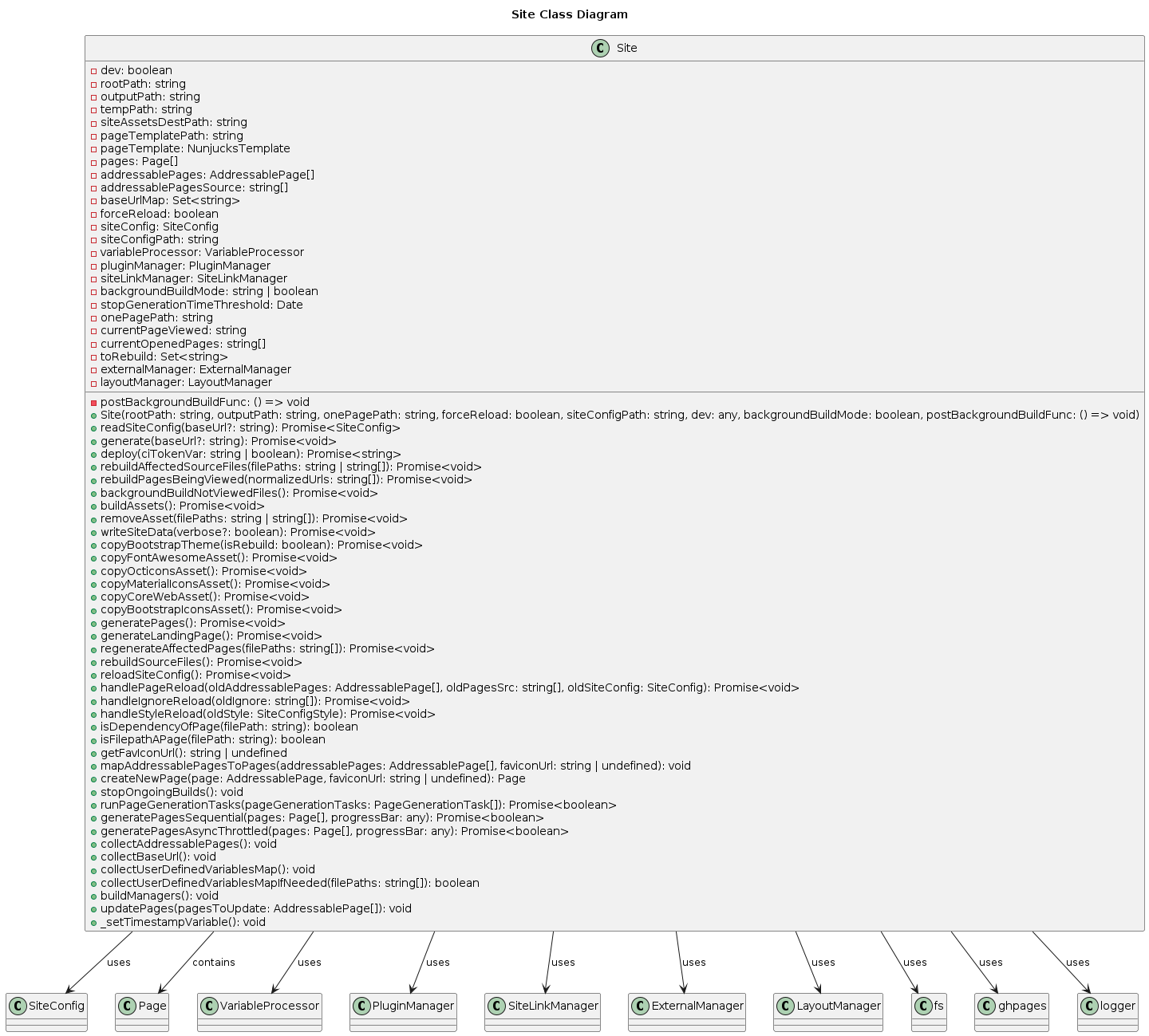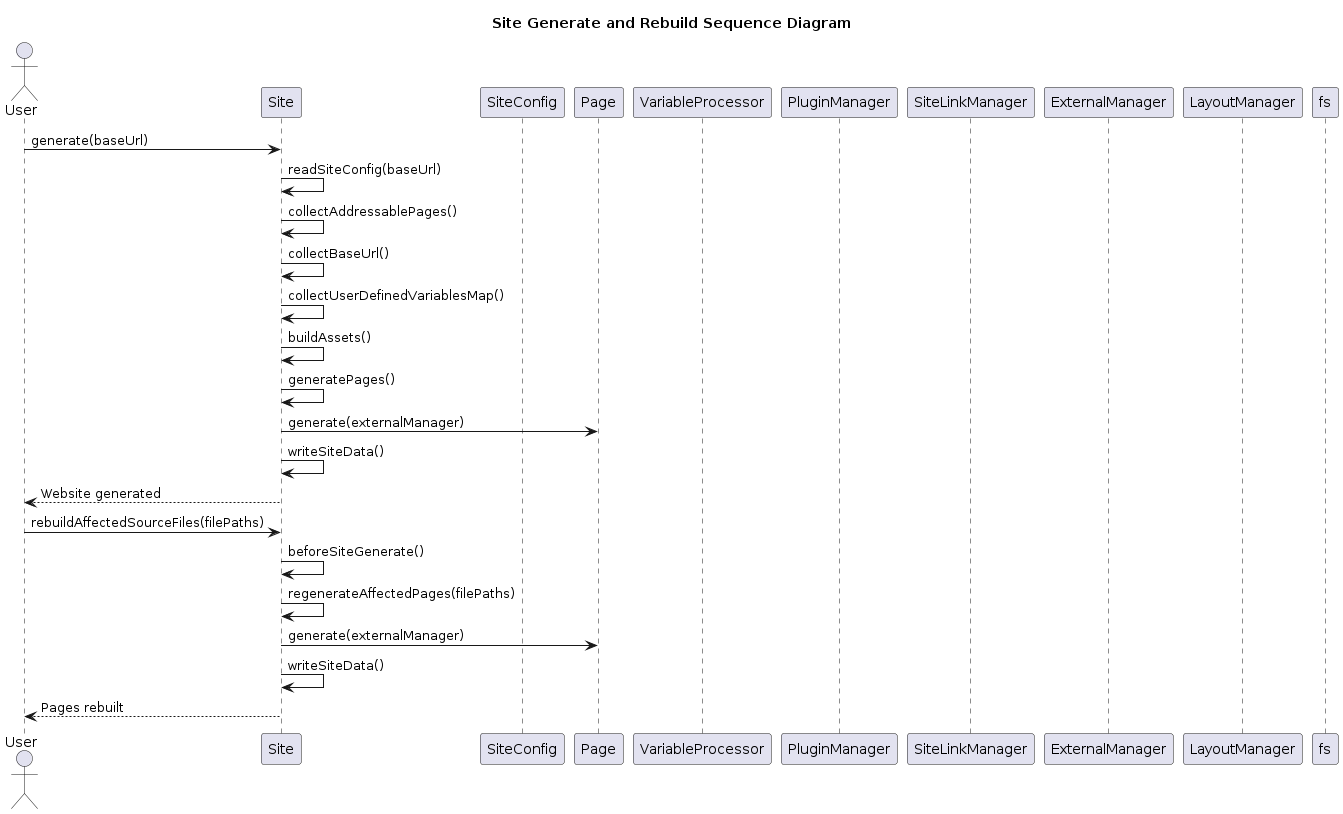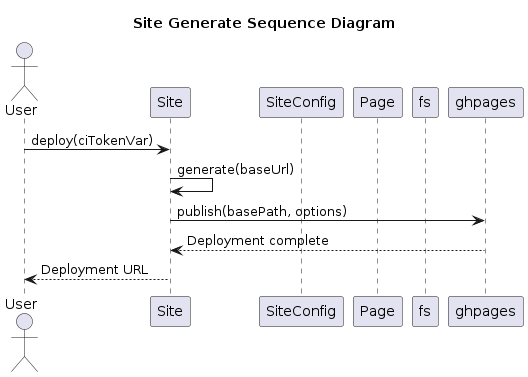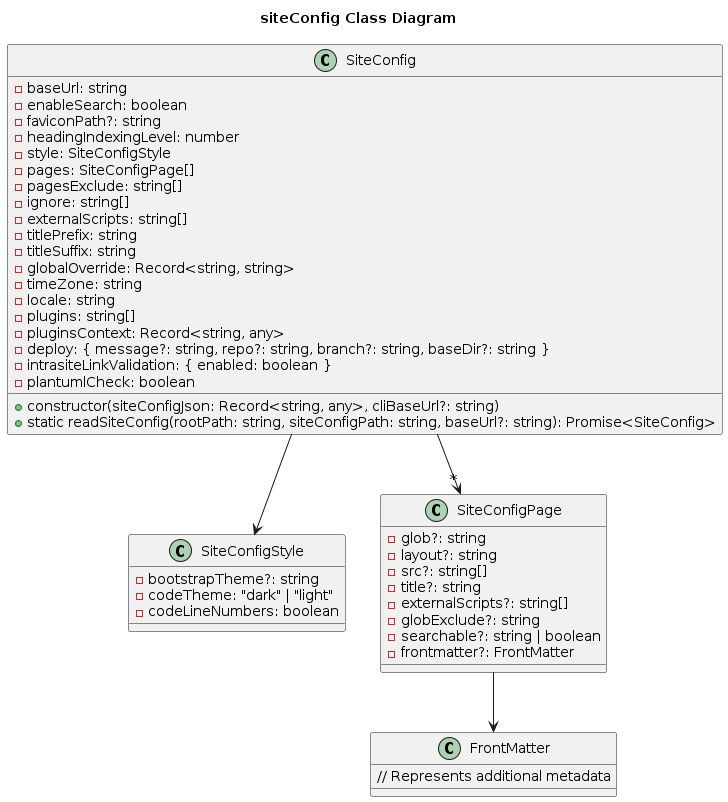Site Class
The Site class is initialized with configuration details (either default or user-specified) and is responsible for tasks such as generating the static site, handling page rendering, and deploying the built site to a GitHub repository.
It interacts with other classes like SiteConfig, Page, VariableProcessor, PluginManager. Key methods of Site include generate, rebuildAffectedSourceFiles, deploy, and buildAssets. The component diagram helps to visualize the interactions between the Site class and the external components such as fs, gh-pages, and logger.
Site Component Diagram

The arrows represents the interactions between the components. The Site depends on external libraries for related operations, while the site component uses / calls other relevant components to execute specified operations.
The Site class is quite a heavyweight, and here is a class diagram for a large overview:
Site Class Diagram

Site.Generate & Rebuild
In the static site build process, the Site object handles the generation of the site. An overview of this process is shown in the following sequence diagram.

The method buildSourceFiles is called, which in turn calls generatePages(). This renders all pages specified in the site configuration file to the output folder. We do this by running page.generate() for all collected pages.
Similarly, the rebuild process follows a similar process.
Site.Deploy

For deployment, MarkBind makes use of the gh-pages library to publish files to a gh-pages branch on GitHub.
If the no-build option is specified and if the site files are not built, which it verifies with the npm library fs-extra, it will throw an error.
The build process is a pre-requisite of the deployment process.
The deploy process automatically calls the build (generate) process otherwise.
SiteConfig Class Overview
The SiteConfig class is located in packages/core/src/Site/SiteConfig.ts and is responsible for reading, validating, and managing the site configuration (site.json). It provides a structured representation of the configuration with default values for unspecified properties.
This class plays a crucial role in defining key aspects of a MarkBind site, such as:
- Site metadata (title, locale, timezone)
- Page settings (layouts, external scripts, searchability)
- Deployment configuration (GitHub Pages repo, branch, commit message)
- Plugins and extensions (custom plugins and plugin contexts)
The SiteConfig class is primarily used during site initialization, site generation, and deployment.

Key Properties and Functionalities
1. Base URL Handling
this.baseUrl = cliBaseUrl !== undefined
? cliBaseUrl
: (siteConfigJson.baseUrl || '');
The baseUrl is retrieved from the site.json file unless a command-line --baseUrl argument is provided, in which case the CLI value takes precedence.
2. Pages and Layout Configuration
this.pages = siteConfigJson.pages || [];
this.pagesExclude = siteConfigJson.pagesExclude || [];
this.ignore = siteConfigJson.ignore || [];
- pages: Defines the pages included in the site.
- pagesExclude: Specifies files that should be excluded from the site.
- ignore: A list of files that MarkBind should ignore during site generation.
Each page entry can define specific settings such as a custom layout, external scripts, or front matter overrides.
3. Styling Configuration
this.style = siteConfigJson.style || {};
this.style.codeTheme = this.style.codeTheme || 'dark';
this.style.codeLineNumbers = this.style.codeLineNumbers !== undefined
? this.style.codeLineNumbers : false;
Defines the site's styling preferences, including,
- codeTheme: Can be 'dark' or 'light'.
- codeLineNumbers: Determines whether line numbers should be displayed in code blocks (default: false).
4. Deployment Configuration
this.deploy = siteConfigJson.deploy || {};
Stores deployment-related settings such as,
- repo: The repository to deploy the site to.
- branch: The branch used for deployment (e.g., gh-pages)
- message: The commit message for deployment,
- baseDir: The base directory for deployment.
This configuration is used by the markbind deploy command when pushing the generated site to GitHub Pages.
5. Plugin System
this.plugins = siteConfigJson.plugins || [];
this.pluginsContext = siteConfigJson.pluginsContext || {};
- plugins: Stores a list of active plugins for the site.
- pluginsContext: Holds specific configuration settings for each plugin.
This allows users to extend MarkBind’s functionality with custom plugins.
6. Intrasite Link Validation
this.intrasiteLinkValidation = siteConfigJson.intrasiteLinkValidation || {};
this.intrasiteLinkValidation.enabled = this.intrasiteLinkValidation.enabled !== false;
Ensures that internal links within the site are valid and do not point to non-existent pages.
7. Reading the Site Configuration File
static async readSiteConfig(rootPath: string, siteConfigPath: string, baseUrl?: string): Promise<any> {
try {
const absoluteSiteConfigPath = path.join(rootPath, siteConfigPath);
const siteConfigJson = fs.readJsonSync(absoluteSiteConfigPath);
const siteConfig = new SiteConfig(siteConfigJson, baseUrl);
return siteConfig;
} catch (err) {
throw new Error(`Failed to read the site config file '${siteConfigPath}' at`
+ `${rootPath}:\n${(err as Error).message}\nPlease ensure the file exists or is valid`);
}
}
Reads the site.json configuration file and initializes a SiteConfig object. If the file does not exist or is invalid, an error is thrown.